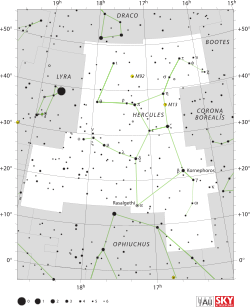Omicron Herculis

| |
| Observation data Epoch J2000 Equinox J2000 | |
|---|---|
| Constellation | Hercules |
| Right ascension | 18h 07m 32.55073s[1] |
| Declination | +28° 45′ 44.9679″[1] |
| Apparent magnitude (V) | 3.83[2] |
| Characteristics | |
| Spectral type | B9.5 V[3] |
| U−B color index | –0.07[2] |
| B−V color index | –0.02[2] |
| Variable type | γ Cas |
| Astrometry | |
| Radial velocity (Rv) | –29.5[4] km/s |
| Proper motion (μ) | RA: –0.02[1] mas/yr Dec.: +8.55[1] mas/yr |
| Parallax (π) | 9.65 ± 0.16[1] mas |
| Distance | 338 ± 6 ly (104 ± 2 pc) |
| Details | |
| Rotational velocity (v sin i) | 194[5] km/s |
| Other designations | |
Omicron Herculis (o Her, o Herculis) is a multiple star system in the constellation Hercules. It has the traditional name Atia and the Flamsteed designation 103 Herculis.
Properties
Omicron Herculis is a B9.5V star approximately 106 pc from the Earth. It has an apparent magnitude of 3.83, and an absolute magnitude of -1.29. The star burns bluish-white, and has a luminosity approximately 180x as bright as the Sun. Omicron Herculis is 3.32 solar masses.
Omicron Herculis is an eruptive variable of the Gamma Cassiopeia class, which are rapidly rotating B-class stars with mass outflow.
Omicron Herculis is both a spectroscopic and an interferometric binary star with a separation of 0.1 arcsec.
Omicron Hercules is notable for residing at the same coordinates as the proper motion of the Sun. It will eventually become the brightest star in the sky in approximately 3 million years from today, at -0.4, slightly less bright than Canopus today.
See also
- Lists of stars in the constellation Hercules
- Spectral type B
References
- 1 2 3 4 5 van Leeuwen, F. (November 2007), "Validation of the new Hipparcos reduction", Astronomy and Astrophysics 474 (2): 653–664, arXiv:0708.1752, Bibcode:2007A&A...474..653V, doi:10.1051/0004-6361:20078357.
- 1 2 3 Johnson, H. L.; et al. (1966), "UBVRIJKL photometry of the bright stars", Communications of the Lunar and Planetary Laboratory 4 (99), Bibcode:1966CoLPL...4...99J.
- ↑ Cowley, A.; et al. (April 1969), "A study of the bright A stars. I. A catalogue of spectral classifications", Astronomical Journal 74: 375–406, Bibcode:1969AJ.....74..375C, doi:10.1086/110819
- ↑ Wilson, Ralph Elmer (1953), General Catalogue of Stellar Radial Velocities, Washington: Carnegie Institution of Washington, Bibcode:1953QB901.W495......
- ↑ Royer, F.; Zorec, J.; Gómez, A. E. (February 2007), "Rotational velocities of A-type stars. III. Velocity distributions", Astronomy and Astrophysics 463 (2): 671–682, arXiv:astro-ph/0610785, Bibcode:2007A&A...463..671R, doi:10.1051/0004-6361:20065224.
External links
| ||||||||||||||||||||||||||||||||||